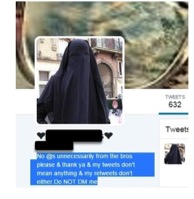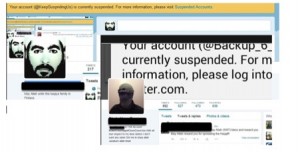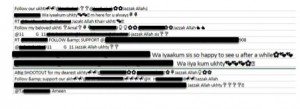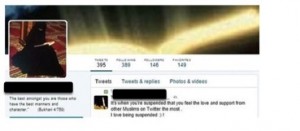by Elizabeth Pearson
In the past two years, the so-called Islamic State (IS) has made Twitter its own, many of its supporters even describing the social media forum as an IS ‘wilayat’ or ‘province’. As academics and policy-makers alike become increasingly aware of the role of the online environment in radicalisation, the use of Twitter as a propaganda platform by Islamic State is a major concern. It is well known that Twitter is heavily populated with both official accounts, and with thousands of unofficial accounts from supporters across the world. The latter have multiple roles, and engage in recruiting, in disseminating messages and video links, and in creating a close-knit and supportive virtual community.
This community can be understood in gendered terms, as members further sub-divide into male and female networks. This division consists of a more or less adhered-to, self-imposed gender segregation, with both men and women expressing caution over too much ‘free-mixing’ online, and many accounts requesting members of the opposite sex to not ‘DM’ them with personal messages.
A key question is how the IS reliance on Twitter should be addressed. So far ‘suspension’ has been the fundamental weapon in the Twitter armoury. It is aimed at abusive behaviour, and also against misuse by extremist movements advocating violence and hate, often in the most graphic and brutal terms. In their ISIS Twitter Census (2015), Berger and Morgan recommend suspension as a way of effectively limiting the online expansion of ISIS networks. While detractors argue those suspended inevitably return, Berger and Morgan believe this is no argument for allowing accounts to remain: “The consequences of neglecting to weed a garden are obvious, even though weeds will always return” (p.15). For Berger, taking down accounts is a positive step against Jihadis, because getting suspended accounts back up and running again “wastes their time”.
In July 2015 I began my own research into IS’ online Twitter supporters, thanks to VOX-Pol’s Researcher Mobility Programme. As part of my PhD studies in gender and radicalisation at King’s College London, my interest was in differences in behaviour, action, content and networks between both ‘male’ and ‘female’ self-declaring IS-supporters on Twitter. I use quotation marks, because on social media, as Joshua Goldberg, who maintained online Jihadi, Nazi and radical feminist personae recently demonstrated, identities are what we make of them. I gathered a dataset of c.40 men and c.40 women, and then began both content analysis, and the use of Twitonomy analytics to research their basic patterns of online behavior and better understand their tweets. The sample is of mixed age, and appears to be spread across a number of countries. Some claim to be in Syria and Iraq. Others in Europe, Africa, the Americas and Asia. This research is ongoing.
A frustrating aspect of the study was the frequent suspension of accounts in my dataset. Each day I would check the sample, to see who had ‘e-survived’ the night. July saw several mass suspensions by Twitter, forcing me to search repeatedly for missing sample members. In effect, I was undertaking the same task as those suspended. While they were seeking old friends, I was trying to maintain the data-set. Mostly, I was successful. Suspension was not a strategy that seemed to deter the members of my group. In all, 16 of the 47 women in the dataset were suspended during the study, and 12 of the 41 men. Some of the accounts had also previously returned from suspension.
Suspension: Integral to Twitter Life
What I began to notice was the way in which suspension was incorporated into the online identity of my dataset, becoming an event in their ‘twitter lives’ around which community and identity are fostered, and in gendered ways. Men and women both build suspension into their online lives, but the way in which they do this differs.
Firstly, this was evident in the biographies and handles of many of the accounts. When signing up to Twitter, a new user chooses an ‘@’ address or handle, and a name. Both can be changed during your Twitter life, as long as you do not choose a name that someone else has already taken. You are also invited to write a few lines of biography, so that others know who you are. Post-suspension, many users created both biographies and handles that represented their resilience in the face of having been taken down. This was particularly true of the self-identifying men in the sample, of whom 27% reference suspension in their Twitter profile information. By contrast, 17% of the women in the sample used their profile information to indicate past suspension.
For example, Abu H uses his biography to compare suspension to the trials of the prophet Muhammad:
Many of the dataset regarded suspension as a tool to persecute specific groups, including Muslims, posting comments such as, “I got #Radicalised when me and my people started to get suspended on every social media platform” and “RT @_xxx_4_IS: @xxx_2 Dear akhi, could you please give me a shout out? There has been a major Twitter purge targeting Muslims”.
The act of suspension serves to confirm a sense of moral righteousness in the IS brand of Islamic belief, as opposed to Twitter, which represents the non-believers or kuffar, as this user demonstrates on return:
“New Account You know the drill. Make Allah happy and anger the kufar! Follow and spread” followed by, “.. the kuffs are so desperate. Each time they suspend us they take great sin upon themselves”.
Abu B F and Abu D R reference past suspension in their image headers:
And Abu Q made light of his suspension with his handle name:
It was as if suspension were an online version of jail-time. Many of the sample use a # in their biography to note the number of times they had returned; the more the better. Surviving suspension was another demonstration of baqiya, the enduring nature of Islamic State in the face of adversity from the kuffar, and a badge of honour for those who had made it back.
This pattern among the men is pronounced enough to draw occasional scorn from other male IS supporters, Abu TLT for example tweeting:
“Whats up with this new trend of “Twitter Veteran” in Bio , Get A Life Fellas”
The ‘trend’ is also seen in the women’s profiles, although to a lesser degree in this sample. Umm Q for example compares her ability to come back post-suspension with an epidemic of plague-like proportions:
The second way in which suspension is incorporated into the Twitter life of the sample was evident in content analysis of tweets, in which suspension figures as both an event, and a topic of importance. After suspension, the re-establishing of an account takes on an almost ritual format. The returnee announces they are back, and relies on ‘shout-out’ accounts and other IS supporters to help them retrieve followers. Then follows a back-and-forth of retweeting and thanks. In my sample, men and women employ a slightly different tone in this process.
Among the women, there is an active display of warmth and love for those helping them get their accounts back into play. The ‘Ukthi-hood’ of IS sisters is marked by the prolific use of happy emoticons and a formalised way of thanking, in Arabic, new Twitter IS supporters guided by more established ones in the form this takes.
This warmth is reserved only for fellow IS supporters. When suspended again, the above cited IS supporter comes back with “They made their best to defeat us but kuffar doesnt know they can’t let us our spirit down we came back” accompanied by violent emoticons:
73% of the women who return follow this ritual of return and elaborate thanks to those retweeting them. The men too follow this pattern, 75% of those returning adhering to the format. The key difference among the sample men is a lesser use of emoticons, and a more blasé engagement with the fact of the return, treating it with humour over warm emotion. One male user tweets “Wallah im loving it enraging the kuffar come join in loool I love shahdah so ready to get suspended”. The more blasé stance towards suspension within the male sample is evident in how much returnees discuss suspension. Tweets about or explicitly following suspension constitute some 24% of the women’s tweets and have varying aims: re-establishing own account, others’ accounts, and discussing the consequences, likelihood and the cause of suspensions, or where other users have gone. For the men returnees, ‘suspension conversation’ accounts for some 20% of tweets.
Male and Female Communities, Male and Female Roles
This ritual of return post-suspension and the different way in which it is expressed for men and women is important. Each uses suspension to create a community of men, and of women, within the broader networks. The way in which they engage with suspension indicates the broader roles they adopt, as male and female supporters of IS.
The women’s sense of love and support enables them to promote men primarily as the fighters, women as carers, home-makers and supporters, as well as passionate advocates of the IS ideology. Very few of my sample support women in violent offline roles. The tightly conformist community enables a strict policing of IS women supporters’ behavior, their dress, modesty and engagement with men on Twitter.
It also provides a way of reaching out and protecting the ‘baqiya family’ against behaviours and people perceived as immoral. Suspension enables both the formulation of community, and the establishing of boundaries between in- and out-groups. Shout-outs support certain accounts, yet warn against others:
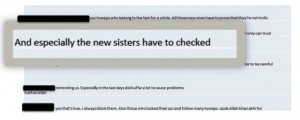
The men also police women’s behaviour, and urge one another to the honour of eventual martyrdom. The communities they form on Twitter have one central aim, wherever in the world they are, as this user suggests:
“RT xxx Wallaahi I cannot wait for the day that I meet all of my twitter bros, standing together in the front lines of battles”
Conclusions
While my research is ongoing, these observations have implications for the current strategy of suspension as a way of countering the IS Twitter community.
The issue is not around the numbers making it back, but about the function of returning. Re-establishing accounts post-suspension should not be regarded as a ‘waste of time’. Community in the ‘Wilayat Twitter’ performs much the same function as in the offline environment, and the act of re-emerging post-suspension is a way of instituting that.
Nor should suspension be seen as peripheral to the main function of IS Twitter accounts. The act of suspension is incorporated into online identities, into biographies, handles, names, and images. It is a key topic of communication and of tweets, and as such it is part of the ‘core business’ of ISIS Twitter users.
The reinforcement of community online through suspension should additionally be understood in the context of current theory on radicalisation. Identification with a beleaguered global Ummah, under constant attack from ‘kuffar’ is a key theme in recruitment. The sense of IS supporters ‘under attack’ is evident on Twitter, just as it is in the offline environment. Whether suspensions diminish the size of networks is something I have not yet explored. However, the idea of ‘community’ is distinct from and no less important than that of ‘networks’. What does seem clear is that, Twitter’s policy of suspension has a role in fostering community among IS supporters. More research is therefore needed on the costs versus benefits of this approach.
Elizabeth Pearson is a PhD Candidate at King’s College London and Associate Fellow RUSI. The research reported on above was carried out at Dublin City University under the supervision of Dr. Maura Conway as part of VOX-Pol’s Researcher Mobility Programme. Follow Elizabeth on Twitter @lizzypearson

